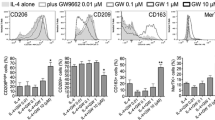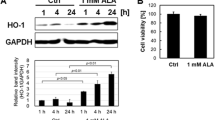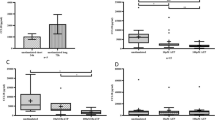Abstract
The inhibition of mevalonate pathway by the aminobisphosphonate alendronate (ALD) has been previously associated with an augmented lipopolysaccharide-induced interleukin-1beta (IL-1β) secretion in monocytes, as demonstrated in an auto-inflammatory disease known as mevalonate kinase deficiency (MKD). In this study we investigated the effect of ALD + LPS on monocyte cell line (Raw 264.7) death. ALD strongly augmented LPS-induced programmed cell death (PCD) as well as IL-1β secretion in Raw murine monocytes, whereas necrosis was rather unaffected. ALD + LPS induced caspase-3 activation. Inhibition of IL-1β stimulation partially restored cell viability. These findings suggest that the inhibition of mevalonate pathway, together with a bacterial stimulus, induce a PCD partly sustained by the caspase-3-related apoptosis and partly by caspase-1-associated pyroptosis. The involvement of pyroptosis is a novel hit in our cell model and opens discussions about its role in inflammatory cells with chemical or genetic inhibition of mevalonate pathway.






Similar content being viewed by others
Abbreviations
- A:
-
Annexin V
- ALD:
-
Alendronate
- FOH:
-
Farnesol
- GGOH:
-
Geranylgeraniol
- GOH:
-
Geraniol
- IL-1β:
-
Interleukin-1beta
- IL-1RA:
-
IL-1β receptor antagonist
- LIM:
-
Limonene
- LPS:
-
Lipopolysaccharide
- ManA:
-
Manumycin A
- MKD:
-
Mevalonate kinase deficiency
- MOH:
-
Menthol
- PCD:
-
Programmed cell death
- PI:
-
Propidium iodide
References
Kuijk LM, Mandey SH, Schellens I et al (2008) Statin synergizes with LPS to induce IL-1beta release by THP-1 cells through activation of caspase-1. Mol Immunol 45:2158–2165
De Leo L, Marcuzzi A, Decorti G, Tommasini A, Crovella S, Pontillo A (2010) Targeting farnesyl-transferase as a novel therapeutic strategy for mevalonate kinase deficiency: in vitro and in vivo approaches. Pharmacol Res 61:506–510
Marcuzzi A, Pontillo A, De Leo L et al (2008) Natural isoprenoids are able to reduce inflammation in a mouse model of mevalonate kinase deficiency. Pediatr Res 64:177–182
Pontillo A, Paoluzzi E, Crovella S (2010) The inhibition of mevalonate pathway induces upregulation of NALP3 expression: new insight in the pathogenesis of mevalonate kinase deficiency. Eur J Hum Genet 18:844–847
Toyras A, Ollikainen J, Taskinen M, Monkkonen J (2003) Inhibition of mevalonate pathway is involved in alendronate-induced cell growth inhibition, but not in cytokine secretion from macrophages in vitro. Eur J Pharm Sci 19:223–230
Bergsbaken T, Fink SL, Cookson BT (2009) Pyroptosis: host cell death and inflammation. Nat Rev Microbiol 7:99–109
Fink SL, Cookson BT (2005) Apoptosis, pyroptosis, and necrosis: mechanistic description of dead and dying eukaryotic cells. Infect Immun 73:1907–1916
Mosmann T (1983) Rapid colorimetric assay for cellular growth and survival: application to proliferation and cytotoxicity assays. J Immunol Methods 65:55–63
Moss JE, Aliprantis AO, Zychlinsky A (1999) The regulation of apoptosis by microbial pathogens. Int Rev Cytol 187:203–259
Kastelan M, Prpic-Massari L, Brajac I (2009) Apoptosis in psoriasis. Acta Dermatovenerol Croat 17:182–186
Marcuzzi A, Tommasini A, Crovella S, Pontillo A (2010) Natural isoprenoids inhibit LPS induced-production of cytokines and nitric oxide in aminobisphosphonate-treated monocytes. Int Immunopharmacol 10:639–642
Mo H, Elson CE (2004) Studies of the isoprenoid-mediated inhibition of mevalonate synthesis applied to cancer chemotherapy and chemoprevention. Exp Biol Med (Maywood) 229:567–585
Hirota R, Roger NN, Nakamura H, Song HS, Sawamura M, Suganuma N (2010) Anti-inflammatory effects of limonene from yuzu (Citrus junos Tanaka) essential oil on eosinophils. J Food Sci 75:H87–H92
Dunford JE, Rogers MJ, Ebetino FH, Phipps RJ, Coxon FP (2006) Inhibition of protein prenylation by bisphosphonates causes sustained activation of Rac, Cdc42, and Rho GTPases. J Bone Miner Res 21:684–694
Rung E, Friberg PA, Bergh C, Billig H (2006) Depletion of substrates for protein prenylation increases apoptosis in human periovulatory granulosa cells. Mol Reprod Dev 73:1277–1283
Nagashima T, Okazaki H, Yudoh K, Matsuno H, Minota S (2006) Apoptosis of rheumatoid synovial cells by statins through the blocking of protein geranylgeranylation: a potential therapeutic approach to rheumatoid arthritis. Arthr Rheum 54:579–586
Bannerman DD, Goldblum SE (2003) Mechanisms of bacterial lipopolysaccharide-induced endothelial apoptosis. Am J Physiol Lung Cell Mol Physiol 284:L899–L914
Miao EA, Leaf IA, Treuting PM et al (2010) Caspase-1-induced pyroptosis is an innate immune effector mechanism against intracellular bacteria. Nat Immunol 11:1136–1142
Mandey SH, Kuijk LM, Frenkel J, Waterham HR (2006) A role for geranylgeranylation in interleukin-1beta secretion. Arthr Rheum 54:3690–3695
Callejas JL, Oliver J, Martin J, Ortego N (2007) Anakinra in mutation-negative CINCA syndrome. Clin Rheumatol 26:576–577
Hawkins PN, Lachmann HJ, Aganna E, McDermott MF (2004) Spectrum of clinical features in Muckle-Wells syndrome and response to anakinra. Arthr Rheum 50:607–612
Granel B, Serratrice J, Disdier P, Weiller PJ (2005) Dramatic improvement with anakinra in a case of chronic infantile neurological cutaneous and articular (CINCA) syndrome. Rheumatology (Oxford) 44:689–690
Haas D, Hoffmann GF (2006) Mevalonate kinase deficiencies: from mevalonic aciduria to hyperimmunoglobulinemia D syndrome. Orphanet J Rare Dis 1:13
Braun T, Fenaux P (2008) Farnesyltransferase inhibitors and their potential role in therapy for myelodysplastic syndromes and acute myeloid leukaemia. Br J Haematol 141:576–586
Nevyjel M, Pontillo A, Calligaris L et al (2007) Diagnostics and therapeutic insights in a severe case of mevalonate kinase deficiency. Pediatrics 119:e523–e527
Acknowledgments
The authors are grateful to Dr. A. Tommasini (Paediatric Division, IRCCS “Burlo Garofolo”) for providing Kineret®. This work was supported by a grant from the Institute for Maternal and Child Health IRCCS “Burlo Garofolo” (RC 13/08). SC is recipient of a fellowship grant from European Project “Talents for an International House” within the framework of the 7th Research & Development Framework Programme PEOPLE—Marie Curie Actions—COFUND (Co-Funding of Regional National and International Programmes).
Conflict of interest
None.
Author information
Authors and Affiliations
Corresponding author
Rights and permissions
About this article
Cite this article
Marcuzzi, A., Piscianz, E., Girardelli, M. et al. Defect in mevalonate pathway induces pyroptosis in Raw 264.7 murine monocytes. Apoptosis 16, 882–888 (2011). https://doi.org/10.1007/s10495-011-0621-1
Published:
Issue Date:
DOI: https://doi.org/10.1007/s10495-011-0621-1




